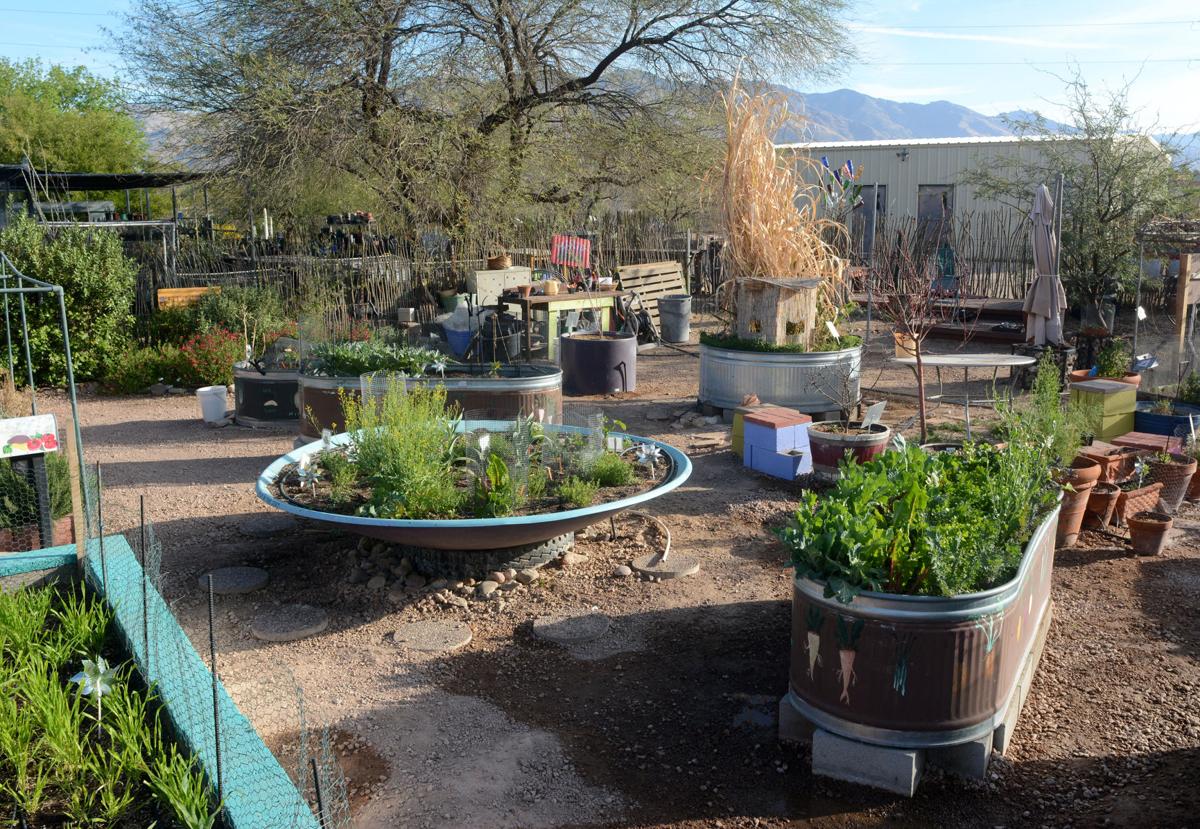As with many other gardening efforts, growing veggies here in the desert has its unique challenges. In much of the country, people like growing their veggies in raised beds. You should know, however, that there is another option — sunken beds — that offers some advantages in our climate.
Let’s first discuss why we use raised beds. Beds are basically large containers which allow us to control the type of soil and the nutrients that go into it. In a desert, where soil is so different from the soil in places where these food plants normally grow, this can be a great advantage. But any container has two big disadvantages, which are related: limited soil depth and susceptibility to drying out. This is where sunken beds come in.
Both types of veggie beds have their pros and cons. Which one you use (or maybe a combination of both) depends partly on your needs and preferences, and partly on the features of the site where you grow your food.
Keep in mind that the features outlined here can also help you decide how to grow other container-based plants, including nonnative ornamentals, cut flowers, roses, and the like.
Creating sunken beds
Sunken beds are created by digging out an area of native soil to create a large, deep basin that you then fill with the soil you want to use for growing your veggies. The most important thing is to get rid of all of the caliche, which is your biggest enemy when you’re planting non-native plants in native soil. You need to dig down about 2 feet so that even your deep-rooting veggies have plenty of room to grow.
What do you fill your sunken beds with? It depends on the type of native soil you have. If your soil is very sandy, you will need to mix it with a lot of various amendments before it’s good enough for growing most veggies. Likewise, clay soils will need to be mixed with other types of soil to prevent your beds from turning into a swamp.
You can mix some of your native soil with soils optimized for vegetable gardening. One mix that’s compatible with our soils and climate is Tank’s Pro Planting Mix. You can top your beds with a nice thick layer of compost and mulch. If you’re lucky enough to have good soil, just top with compost or other organic matter and then mulch to keep moisture in and weeds out.
If you have critter issues, I suggest you line your in-ground beds with chicken wire or hardware cloth. This will keep underground animals from digging into your beds and eating your crops. Don’t forget about water — sunken beds will need to have a dedicated irrigation system just like raised beds.
Pros
- You can usually use more native soil, saving you money
- Cheaper than buying raised bed containers
- Keep your plants from drying out in our harsh climate allowing for less water use
- Better drainage
Cons
- Are at ground level, so more difficult access
- Takes a lot of digging, particularly in caliche-heavy soils
- If you have poor soil, you will still need to fill with off-site soil
- Can’t be moved around
Container beds
Container beds can, in theory, be made out of anything. You can use scrap wood, cinder blocks, bricks, metal containers, and other materials. Their appearance, size, and variety is limited only by your budget and your imagination. Container beds can be set at ground level or can be placed up on elevated struts to make for easy access with no bending. They can be set up over soil or in paved areas.
There are some caveats, however. I recommend against using railroad ties or treated wood as these contain toxins that may leach into the soil and thus into your food. If you’re setting them up over a paved area, your drainage will be limited, and will cause permanent staining of the patio material. You need to make sure that whatever container you use has drainage holes, or you will end up with unhealthy anaerobic soil.
Pros
- Can be elevated for ease of access
- Style and size can match any decor and yard plan
- Can be moved around (depending on size and installation)
Cons
- Dry out and heat up more quickly than in-ground beds
- Can be more expensive depending on materials used
- Need imported soil which can also get expensive
You may decide to combine the best of both worlds. For example, you may decide to grow summer veggies in the ground and winter veggies in containers — assuming you have the yard space for both. And remember - if your plan doesn’t work out, you can always change things up next year.





